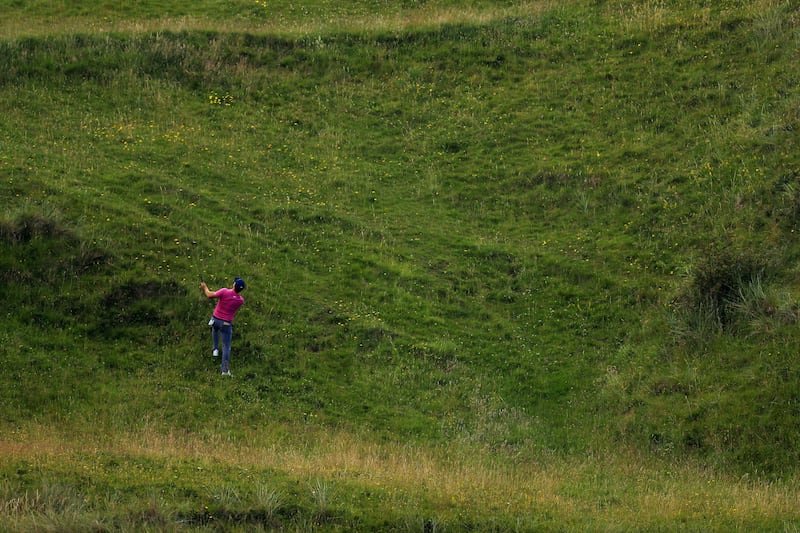“Of all the hazards, fear is the worst” – Bobby Jones.
For most of us mere mortals, the sight from the tee to the green on the 16th hole of the Dunluce links at Royal Portrush is both mesmerising and fear invoking.
Calamity Corner, as it is known, is unquestionably one of golf’s great par 3s, with a deep chasm to the right and a tiny bailout landing area short left of the green. Off the championship tee which, obviously, will be in play for the 153rd Open in the next week, it is a monster of a hole. It is also the highest point on the course, and one of the most exposed.
Back in his amateur days of playing in the North of Ireland championship, Pádraig Harrington recalls using a driver for one tee shot into a strong wind.
READ MORE
While a driver is unlikely to be in hand for any of these modern-day professionals in their quest to claim the Claret Jug, the task for one and all – of finding the green – will, in itself, be a challenge and especially so given that it comes so late in the round where the ability to rescue a card is lessened.
Calamity overlooks the Valley course to the right, where part of that links has been turned into a driving range during The Open, and, hands up, the majority of times that I’ve played (to use the word loosely) the hole, my time has invariably involved negotiating a way down the sheer drop in search of a ball that has been attracted into the chasm as if by some magnetic force. Mountain goat terrain, for sure.

Such a fate will surely befall some poor soul at some stage during the week ahead, when the fourth and final Major of the season returns to the Co Antrim links for a third staging, and its reputation as a “card wrecker,” as Royal Portrush’s club professional Gary McNeill describes it, is one that will prey on the minds of some more than others.
When the 148th Open returned to Royal Portrush in 2019, only 41 per cent of the field – through the four rounds of the championship – managed to find the green with their tee shots on 16. That statistic ranked as the lowest of any green found in regulation. The 16thranked as the third-toughest hole on the course, behind the 11th and 14th holes.
In the run-up to the championship, former champion Henrik Stenson, on first playing the hole in practice, later quipped: “Sixteen is that short, drivable par-4, isn’t it?”
For sure, it is not one that anyone forgets.
“It’s a hole where if you get it wrong you can easily run up a double-bogey or worse, particularly if the player pushes it out to the right and doesn’t make the carry across. The ball has a tendency to bounce and make its way right down to the base of that chasm and then you’re at the mercy of what lie you get down there and you’re trying to play a shot up a very steep bank to a blind target,” explained McNeill of the challenge.
The bottom of the chasm is close to 30m (100ft) below the green, which says all that needs to be said about players ensuring that such an escape act is not required.

In 1951, on The Open’s first visit to the links, the great South African player Bobby Locke made sure such a feat did not fall to him by aiming left of the green in all four rounds. Locke identified a small bowl-shaped hollow to the left, short of the green, and found it, making pars in all four rounds. That small plot is, to this day, known as “Locke’s Hollow”.
Back then, Calamity was actually the 14th and only became the 16th after Martin Ebert of Mackenzie & Ebert golf course architects – who work closely with the R&A on links which form the Open rota – was brought in ahead of the 2019 championship to make course changes which saw the old 17th and 18th holes removed and two new holes, what became the seventh and eighth, created in the dunes of the Valley course, in such a way that it would seem they were always part of Dunluce itself.
“The general feeling was that the course changes led to an improvement of the Dunluce Links. Subsequently, the members and visitors seem to have accepted the changes as having had a positive impact. The immediate sight of the seventh, stretching away in the distance when you turn the corner of the road leading to Portrush, is one of the most exciting views in golf and one that leads to a huge sense of anticipation of what is to come if you are playing the Dunluce,” remarked Ebert of the additions.
Calamity, though, was untouched because it didn’t need to be. It remains as it was when Harry Colt created his masterpiece, his vision for the par 3 for the tee shot to be played across the chasm with all the peril involved.
Calamity Corner – at 236 yards – is not the longest par 3 on the Open rota. The 16th at Carnoustie comes in at 248 yards. The 17th at Royal Troon at 242 yards. Unlike those two, however, it is that chasm – which Colt used so tellingly all those years ago – that, visually, makes it so different.
And, for all its difficulty, and the notoriety that the 16th hole has gained, the examination will be a tough one but a fair one with, as ever, the wind a factor too.
As Darren Clarke, who knows the Dunluce Links as well as any other man, put it, “the thing about Royal Portrush, it’s a fair golf course. If you play well around Portrush you should have the opportunity to score well. If you’re missing too many shots you’re not going to get around Portrush, and that’s the way it is. That’s why it’s a Harry Colt masterpiece.”














